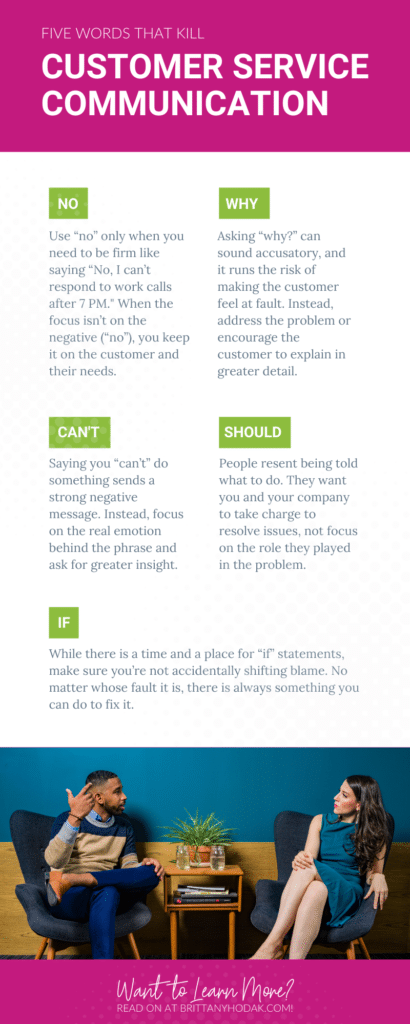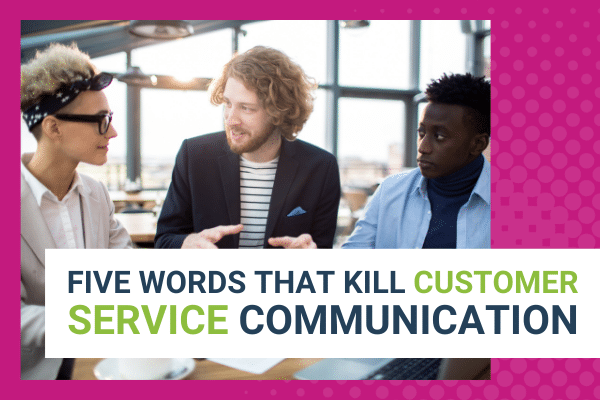When it comes to building trust with customers, actions speak louder than words. That being said, words matter and they carry significance on their own. The right words put customers at ease, while the wrong words might send them running to a competitor. With a reported 54% of consumers saying they have higher service expectations than just one year ago, now is the time to sharpen your customer service communication skills.
Most of the focus in customer service education is on what you should say. Phrases like “the customer’s always right” reign supreme. However, are there some words that directly impact your communication in a negative way? These words unintentionally damage your credibility, though they might seem harmless at first.
From accidentally sounding accusatory to outright negativity, there are 5 specific words known to kill customer service communication. No matter your industry, it’s time to strike the right balance with your vocabulary to make sure you’re sending a positive message. Your customers want to feel heard and valued. When language is too direct or intimidating, this creates a negative experience.
With that in mind, what are these 5 words that kill customer service communication? These words are: “no,” “why”, “can’t,” “should,” and “if.” Odds are, you’ve used them in your own marketing, sales, and communications at some point. While we’re not saying to avoid them 100% of the time, here’s why you need to use them wisely.
“No”
First, the word “no” can be tricky when it comes to customer service. The customer isn’t always right, and there is a time and a place to use the word no. However, the key is to use “no” only when you need to be firm, like when setting a healthy boundary. For example, saying “No, I can’t respond to work calls after 7 PM” is a perfectly reasonable way to use this word.
What’s the problem with the word “no?” Unfortunately, it can come off as too negative. In reality, the answer isn’t usually as black and white as that. Instead, transition into an explanation of a better solution. Instead of saying “no,” consider other ways you can help such as:
- Be transparent about the reasoning behind your no (“I can’t add that to your package because of our new system, but I’d be happy to walk you through other similar options.”)
- Apologize for not being able to meet their request and recommend someone who can (“Unfortunately we only offer catering for weddings, but I’ll share recommendations for workplace caterers.”)
- Suggest alternative options (“I understand you’re looking for a new car. We only have used models, but I think you’ll find these are an even better deal.”)
- Offer to fulfill their request in the future (“We’re fully booked through July, but I can add you to our waitlist or follow up next month.”)
When the focus isn’t on the negative (“no”), you keep the focus on the customer and their needs. It’s about meeting their goals and expectations. Customer service is ranked number one when it comes to building trust with customers. That means you need to approach every interaction as a chance to build a strong relationship.
Instead of “no,” say: “Not at this time,” “I can’t complete your request because…,” or “Let me recommend this instead.”
“Why”
Another word to avoid is “why.” While there might be a time to use this word, it can come off the wrong way if used incorrectly. Asking “why?” out of the blue can sound accusatory, and it runs the risk of making the customer feel at fault. You don’t want to make it seem like you’re asking the customer “Why did you do this?” or “Why are you here?” In other words, it places unnecessary blame on the customer.
Instead, address the problem or encourage the customer to explain in greater detail. Being specific about the information you want from customers is key. They can’t read your mind, and it’s important to be an active listener. When you’re an active listener, you truly listen to what your customer is saying.
One way to avoid asking “why” in the first place is to have a better understanding of your customers, their goals, and their expectations from the start. Any of the following strategies are useful for gaining insights into your customers’ real-world needs:
- Create customer profiles
- Review past feedback
- Encourage customer reviews
- Talk to your target audience
When you learn to anticipate customers’ problems, you become an active part of the solution. Still, when it comes to asking your customers for more information, steer clear of “why” to avoid sounding too accusatory.
Instead of “why,” ask: “What are your goals?”, “What led you to choose this service?”, and “Help me understand what you need.”
“Can’t”
Similar to “no,” saying you “can’t” do something sends a strong negative message. Though there are times you quite literally can’t do something if you’re setting a healthy boundary, you can usually swap this phrase for something gentler. You don’t have to say “I can’t do that” or “we can’t do that” when a more constructive phrase works just as well.
The word “can’t” isn’t very specific. It doesn’t give the customer much information to work with. Instead, focus on the real emotion behind the phrase. Saying you don’t understand, and asking for greater insight is the perfect way to handle most “can’t” situations.
For example, if a customer asks whether you can lower the price of a specific service, you might be tempted to answer that you can’t. Instead, respond with something like, “I’d like to understand your pricing needs so we can discuss a service that works better.”
By clarifying the needs and wishes of the customer, you’re better equipped to solve their problem. Better yet, you take an understanding, compassionate approach to the interaction. This leaves a favorable impression on the customers, and they won’t feel immediately shut down.
Instead of “can’t,” say: “I’m not sure about that, but what about,” “Let me find out what we can do for you,” and “Can you help me understand your needs?”
“Should”
Another accusatory word is “should.” We can all come up with a long list of things we (and others) should do, but we can’t put these expectations on others. In reality, people resent being told what to do. They want you and your company to take charge to resolve issues, not place the responsibility on them.
While it’s easy to respond to a customer service complaint with something like, “What you should do is…” this is a one-way ticket to frustration. Instead, do everything in your own power to solve the problem yourself. When you stay calm and focus on what you can do, your customer trusts your expertise. Let’s say a customer misplaced their order information. Instead of saying they “should” have held onto it, you might say:
- “That’s no problem, you don’t need it because…”
- “I’ll look up your order another way.”
- “Let’s troubleshoot how to find it in your email inbox.”
- “I’ll resend your confirmation right now.”
The same is true for the negative version of “should.” You also don’t need to tell customers what they “shouldn’t” have done. Sure, they probably shouldn’t have thrown away their receipt, ignored your late shipping notification, or failed to read the disclaimer. Either way, telling them this won’t change the situation. It will just make them feel angry and embarrassed.
Instead of “should,” say: “That does sound frustrating,” “Here’s what we can do about this…,” and “I understand, let’s move forward with…”
“If”
Last but not least, be mindful of how you use the word “if.” Though there are times “if” can be used responsibly, it’s usually followed by some sort of shifting of blame. When you play the blame game, nobody wins. For example, saying, “I’m sorry if you didn’t get my last message, but…” places the blame on the customer.
With 4 out of 10 consumers recommending others not to frequent a business after a poor customer service experience, it’s essential to take your words seriously. It’s true that sometimes customers make mistakes. They’re only human. What’s important isn’t what might have happened if they acted in a different way. It’s what you can do to solve their problem.
While there is a time and a place for “if” statements, make sure you’re not accidentally shifting blame. No matter whose fault it is, there is always something you can do to fix it. In fact, by taking this opportunity to turn the situation around, you strengthen your relationship with customers more than before.
Instead of “if,” say: “I understand, here’s what we can do to fix it…,” “Thanks for sharing your experience,” and “It’s no problem at all…”
Optimize Your Customer Service Vocabulary
Ultimately, we’ve all used some of these words before. Sometimes it’s not always clear the impression they leave on customers, but we can all take a moment to consider their true meaning. Clear customer service communication skills are a must for any representative of a company. In every moment, you want to lead with patience, empathy, and modesty.
Though these small interactions might seem unimportant, they create an overall impression of your brand. Over time, they turn into an opportunity to build real-world superfans. Though a picture might be worth 1000 words, your words matter to your customers.

